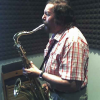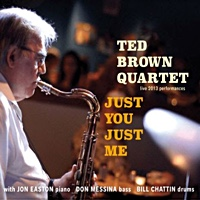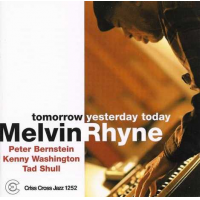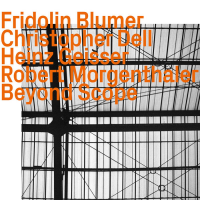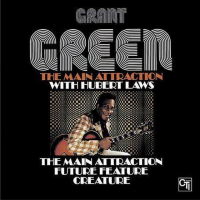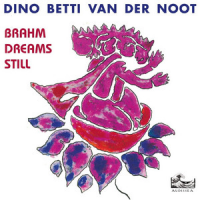Home » Jazz Articles » Liner Notes » Dino Betti van der Noot: A Chance For A Dance
Dino Betti van der Noot: A Chance For A Dance
That concept is bound up in the title of this collection. It's just a matter of giving the music "a chance to dance." And the music of Dino Betti van der Noot, in its latest phase of development, dances with grace and logic, power and delicacy: Grand strides throughout. His is quite possibly the most invigorating and challenging approach to large-ensemble writing in jazz today, drawing on the lesson of the past, processing the present, and helping to define the future of the big band idiom.
The past? As others pointed out, Dino shares with the Ellington legacy a passion for customizing his compositions to the individualized talents of his orchestra. (In fact, this was probably the most vital of Ellington's artistic realizations, since so many enduring pieces—from "The Mooche" through "Crescendo And Diminuendo in Blue"—were based upon it.) When Dino prepares a piece, he creates a frame for the particular quality of the projected soloist—be it the fleet power of a Bill Evans, the cool passion of a Mitchel Forman, or the husky cry of a Carmen Lundy. Explaining his facility with such a wide palette of instrumental sounds, Dino shrugs: "I played many instruments in my life—all of them poorly." (All, I would argue, except one.)
As an example, one of the composer's favorite colleagues, the Italian reedman Gianluigi Trovesi, was the inspiration for "Don't You Feel This Way Too—Sometimes?," which is designed to take advantage of his versatile sound and acrobatic technique on the bass clarinet. Dino has supplied a variety of settings: At the start of Trovesi's solo, the keening of the high reeds counters the bass clarinet's mournful low notes, while a little later on, the woodsy drone of the cello serves as a cushion for Trovesi's upper-register flights. And this piece also provides an example of the sureness of Dino's compositional instincts. "I wrote the theme and found it was not the right beginning—that it was the end of a certain kind of story," he says. "So the theme is exposed only at the end." Like a sherlokian piece of deductive reasoning, the composition thus sorts out and finally reveals its truth as the musical facts tumble in.
As for present, this album is the fourth that Dino has recorded, but it can more accurately be considered the latest chapter in what is already a rich and remarkable body of work. Most obviously, Dino reveals in an impressive range of color and imagery. He programmatically leads his listeners through deserts and up mountains; he navigates exhilaration and despair, conjuring sharp and pure visual images from his wide palette of sounds. But despite his acumen as a total painter—and make no mistake, Dino is a direct descendant of Ellington, via Thad Jones and Toshiko Akiyoshi, in the continuing explosion of timbral possibilities—the freshness of his sound and the originality of his music really lie elsewhere.
Specifically, it is the underlying draftmanship, along with a noteworthy sense of scale and form, that mark Dino's writing. He works on large canvasses; he needs to, because for the most part, he deals with large musical issues (although he fills these canvasses with finely-wrought detail). The title composition of this album supplies the perfect example. The longest of his works—"It was born little by little on the piano," says Dino, who often refers to his pieces in antropomorphic terms—"A Chance for A Dance" raises and solves a variety of artistic problems. In it, Dino wrestles with balance and structure, criss-crossing tonalities, the concurrent development of multiple themes, and fitting the individual (the soloist) into the now disciplined, now anarchic constraints of society (the orchestra). Referring to its multiple sections and recurrent theme, Dino admits, "I didn't think about structure, but I'm happy with the structure that resulted. I think you must have a certain kind of classical background to automatically choose this structure. Each theme brings to the composition a different atmosphere."
At this point in such an essay, the writer usually feels compelled to point out that such clinical concerns should not deter the musically unschooled listener from just "digging in" to enjoy the music. I won't insult your intelligence by doing this. For although specific analytical thoughts need not be the constant companions of any listener or critic, they are quite naturally inspired by most music worth listening to more than once. In fact, such concerns are at the heart of Dino Betti van der Noot's compositional process, and so it can come as no surprise that his music demands intellectual, as well as emotional, responses.
Such is the case in "Sorry—I'm Mine," which features another of the Betti van der Noot repertory company, vocalist Carmen Lundy. "I am trying to explore the relationship between a singer and her public," explains Dino. In so doing, he has backed the soaring melody with some of his thickest instrumental textures; this combination matches the paradox of celebrity—i.e., how does one seek public adulation and yet retain a measure of privacy?—expressed in the lyrics.
And then there is Another Basic Riff, a reworking of an earlier composition; Dino describes it as "an old story of love between me and two chords. You can define them in many ways, but basically, it is F-C-F in the left hand, and D-G-Bb in the right." Dino has voiced these notes throughout the orchestra, but the result is the same as it would be at the keyboard: Sounding the two chords together creates a bitonal clash of F-major and G-minor, a conflict of dissonant tonalities and antithetical modalities. "Then you keep the F-major chord in the 'left hand' and move the 'right hand' up and down," explains Dino, "until you arrive at the perfect chord"—the inevitable resolution, the safe haven that must follow the varying levels of adventure and intrigue.
The impressive, burgeoning accomplishment of Dino Betti van der Noot becomes positively startling with the realization that these compositions are a part-time endeavor. Most Italians are far less familiar with his albums than with the music he writes for Italian commercials: The same could be said of his worldwide colleagues in the advertising industry, who have graced Dino and his firm, the Milan-based B Communications, with a variety of major awards. "Advertising," he says, "is my business—and advertising music is my 'paid hobby.' I try to keep it completely separated [from orchestral compositions]; the only thing they have in common is perfectionism. In either case, I like to communicate in a simple—not easy—direct way, in my music, in my business, in my life."
Cool and quietly elegant in person, Dino is efficient and directed in speech and thought; it is his prolific output, and his relentless attention to detail, that offer telltale proof of his hyper-energetic nature. And yet, he says, "I am not pushing. If I were obliged to make music, the results would not be so good. Normally, I don't even plan to make an album. I am exploring certain possibilities to make music, and when I have enough I make an album."
Lately, those possibilities seem to be multiplying; this album was almost completed at the time Dino's previous work (They Cannot Know) was released, and by the time you have absorbed this one, his next album should be in the can. The forthcoming date will feature Dino's writing for a smaller instrumentation: Four horns and three "orchestra voices" (wordless vocalists), supported by acoustic and electric keyboards, electric bass, drums, and percussion. As further big-band ideas come to mind, they will assigned to the still next album—in other words, the album twice removed from the one in your hands. At this point, Dino's productivity threatens to outstrip that of his reviewers.
Dino's late-1987 performance in New York, where he conducted a hand-picked group of New York musicians, received a mostly favorable notice in the New York Times: The review did, however, suggest that he would be well served to go beyond his own material and utilize his arranging skills on other compositions from the recognizably great jazz composers. It's no surprise, given his quest for perfection, that Dino gave this comment a great deal of consideration; but now, he muses, "I don't think I will change a thing. Because actually, I am not arranging; I am composing."
For Dino, they are one and the same—medium and message, substance and style—and it is the success of this twinning that, more than anything else, sets him apart from the other jazz composers of his time.
Additional Notes by Ira Gitler
Those of you who heard Dino Betti van der Noot's last two albums, Here Comes Springtime and They Cannot Know, do know that in writing and recording some of the most thoughtful, emotion-provoking music of today, combining many sources and blending them within his own vision, he has developed a repertory company like Bergman, SCTV or Ellington (on a far less formal basis) to interpret the results of his inspiration. In addition to the European musicians, most of whom are Italian, Betti van der Noot has included several Americans in key roles. Returning from They Cannot Know are saxophonist Bill Evans, pianist Mitchel Forman, electric bassist Mark Egan, drummer Danny Gottlieb and vocalist Carmen Lundy. A new face is vibraphonist David Friedman. Egan and Gotttlieb, two of the mainstays of the Gil Evans orchestra, both hold Betti van der Noot in high regard. "I find Dino's music to be very experimental and challenging," says Egan. "I'm glad I have had the experience of Gil Evans so I could communicate through Dino's music as well. Dino's music is very challenging for the bass. I also enjoyed playing with the other musicians on the record."Gottlieb feels that "Dino's music is coming from a direction that hits close to home. Gil's influence is in here. It is interesting, unique writing that's not predictable. There are not many people writing that contemporary and open. There's a lot of space to play in the music. Dino lets the personalities of the players come out as opposed to forcing them to play a certain way."
Betti van der Noot's voicings certainly are distinctive and so is the way he uses the flavoring of certain instruments such as the bass clarinet of Gianluigi Trovesi, Hugo Heredia's alto flute, Sergio Fanni's flugelhorn and Attilio Zanchi's cello.
The title track, "A Chance for A Dance," is an ambitious piece of nearly 18 minutes. Dino describes it as "a search to get away from loneliness, to have contact with other people. There's both a negative and positive attraction. And the search always starts over." The yearning theme is exposed by flugelhorns and flutes with piano and percussion underneath. Heredia announces himself with an Oriental cast and this is picked up by piano and flute. Then brass and flutes change the mood, leading to Evans' solo. His alto neither nags nor is too sweet. He develops his solo with logic and passion to a climax with the help of an abrasive ensemble.
The mood changes again with the entrance of Gottlieb on percussion. "It' a rare experience to be able to play the Paiste Percussion Set on a jazz record," he says. "It offers many special textures. Most composers are not aware they exist."
The ensemble accompanies the percussionist on his sonic odyssey with a swelling, chant-like figure. Then brass and vibes usher in Forman and Heredia for a pastoral duet. The theme returns, expansive as before, capped by the echo of the Oriental, leaning toward Japan, motif.
Carmen Lundy's singularly clear, superbly controlled voice is featured on Sorry—I'm Mine with music and words by Dino. It begins with the feel of modern opera but the starkness is resolved with the introduction of the title phrase. A plucked cello and wordless improvisations by a bluesy Lundy take us back into the literary lyric about a songbird (didn't they use to call the female singers with the big bands, thrushes?) away from her true love.
Betti van der Noot tells us that "Don't You Feel This Way Too—Sometimes?" was written with Trovesi in mind. Before the theme has gone too far, vibes echoing in the background, Trovesi becomes a presence, bowed cello underneath. His woody mellowness gives to Dolphy-like articulated arpeggios and jagged guttural cries. Near the end of the solo he sounds as if he is conversing with himself.
Friedman's solo eases in with an acute rhythmic sense. Note the effective use of trills at one point. The theme, never really stated at the onset of the piece, is revealed in a lovely ensemble in which Trovesi's bass clarinet sound can again be discerned.
Heredia's flute plays an introduction and then brings forth the theme of "Blue Gal of My Life" (Dino's wife) as bass and percussion back him. The sad muted trumpets and Ellingtonian piano touches further the indigo mood. Soprano picks up theme. After a pause an alto prefaces Forman's quietly expressive solo with delicate, yet firm, backing from Egan and Gottlieb. Rudy Brass' valve trombone, backed by bowed cello, creates another feeling before muted brass (with vibes commentary) gives away to songful flutes (led by Heredia) and, finally, the theme. Twining flutes let us down gently on a shrush of percussion.
Another Basic Riff begins in a ruminative groove with Forman and Tononi's percussion. The pianist builds the romantic theme in volume and expanse. From the brief silence rises a march-like motif (definitely not military) with brass punctuations. A bluesy strain brings in the first heavy riffing but it quickly gives way to Evans' keening soprano as the ensemble builds to a crescendo under him.
Forman enters again, softly at first and then more forceful as the trombones murmur and the whole ensemble grows more insistent. The vibes toll the time, reeds and brass trade motifs and the riffing rises to the top. After a pause there is a coda with a final burst of brass.
The nature of the improvisations and the conviction and joy with which the ensemble plays Betti van der Noot's music, lets us know that all the musicians share the same feelings expressed by Egan and Gottlieb.
A real, artistic fusion is coming from Europe and Dino Betti van der Noot is one of the most important contributors.
Liner Notes copyright © 2026 Neil Tesser.
A Chance For A Dance can be purchased here.
Contact Neil Tesser at All About Jazz.
GRAMMY-winning author Neil Tesser has written and broadcasted about jazz in Chicago for 50 years. He can be heard Thursday evenings on KSDS-FM.
Track Listing
A Chance For A Dance; Sorry - I'm Mine; Don't You Feel This Way Too - Sometimes?; Blue Gal Of My Life; Another Basic Riff.
Personnel
Dino Betti van der Noot
composer / conductorBill Evans - Saxophone
saxophoneDanny Gottlieb
drumsHugo Heredia
woodwindsGianluigi Trovesi
saxophoneMitchel Forman
keyboardsRudy Brass
trumpetCarmen Lundy
vocalsMark Egan
bassDavid Friedman
vibraphoneGianni Faré
vibraphoneMark Curry
trumpetSergio Fanni
trumpetLuigi Tisserant
trumpetLuca Bonvini
trumpetRon Burton
tromboneDana Hughes
trombone, bassFiorenzo Gualandres
trombone, bassLuis Agudo
percussionTiziano Tononi
drumsAdditional Instrumentation
Rino Lagona, Marco Visconti, Peppino De Mico, reeds & flutes; Luis Agudo.
Album information
Title: A Chance For A Dance | Year Released: 1988 | Record Label: Innowo
Tags
About Dino Betti van der Noot
Instrument: Composer / conductor
PREVIOUS / NEXT
Support All About Jazz
 All About Jazz has been a pillar of jazz since 1995, championing it as an art form and, more importantly, supporting the musicians who make it. Our enduring commitment has made "AAJ" one of the most culturally important websites of its kind, read by hundreds of thousands of fans, musicians and industry figures every month.
All About Jazz has been a pillar of jazz since 1995, championing it as an art form and, more importantly, supporting the musicians who make it. Our enduring commitment has made "AAJ" one of the most culturally important websites of its kind, read by hundreds of thousands of fans, musicians and industry figures every month.





